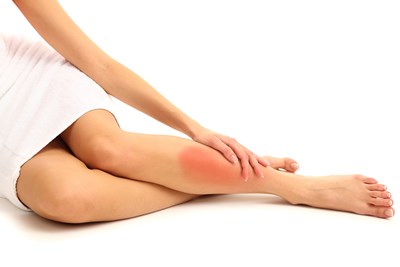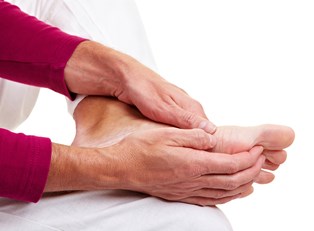Leg pain is common. Minor leg problems, such as sore muscles, occur during sports or recreational activities, work-related tasks, and work or projects around the home. Leg problems also can be caused by injuries. Leg problems may be minor or serious, and symptoms often develop from exercise, everyday wear and tear, or overuse. Older adults have a higher risk for leg pain because they lose muscle mass as they age. Children may have leg pain for similar reasons as adults or for reasons specific to children only, such as problems caused by over activity or the rapid growth of bone and muscle commonly known as "growing pains." Leg pain that is not related to a specific injury has many possible causes. Overuse may occur when one overdoes an activity, repeats the same activity, or suddenly increases exercise. Examples of overuse conditions include bursitis, tendinitis, shin splints, stress fractures, and plantar fasciitis. Muscle cramps in the leg can be caused by activity or dehydration, which can cause leg pain. Problems affecting the blood vessels (vascular disease) can include peripheral arterial disease, inflammation of a vein, or a blood clot, which may cause pain, swelling, or discoloration. Other diseases related to arthritis can cause joint pain, stiffness, and swelling.
Leg Pain Symptoms
Most leg pain symptoms are the result of wear and tear, overuse, or injuries of joints, bones, muscles, ligaments, tendons or other soft leg tissues. Symptoms of injury or overuse, and usually accompanied with leg pain, can include swelling, cramps, numbness, tingling, weakness, or changes in temperature and color. A blood clot near the surface of the skin may cause only minor problems, while a clot in a deep vein may be more serious. Recent surgery, especially on bones or the pelvic or urinary organs, increase the risk of blood clots. Prolonged immobilization of a limb can be caused by extended bed rest and inactivity. Problems affecting the arteries can cause cramping pain that occurs with predictable amounts of exercise, such as walking a short distance but improves with rest. Numbess, tingling, or loss of function in one or both legs can be caused by a transient ischemic attack (TIA) or a stroke. Varicose veins and swelling results from conditions related to weight gain, such as obesity and pregnancy. Leg pain may also be a side effect of medications like birth control pills, water pills, heart medicines and cholesterol-lowering medicines (statins). Symptoms of restless legs syndrome include prickling, creeping, crawling, tingling with an irresistible urge to move the legs.
Leg Pain Treatment
Most minor leg pain and other problems will heal on their own, and home treatment may be all that is needed to relieve symptoms and promote healing. To help prevent cramps, one should stretch the leg muscles often, drink plenty of water and include lots of high-potassium food in one's diet. To relieve mild pain and swelling, one should stay off his or her legs as much as possible. Apply an ice pack or bag of frozen peas to the affected area for fifteen to twenty minutes three times a day. Elevate the leg when sitting or lying down. For best results, begin this treatment within forty-eight hours of an injury. Once the swelling subsides in two or three days, apply moist heat to help restore flexibility and range of motion. But serious leg problems also may occur and require prompt evaluation by a doctor. One who has pain during or after walking, swelling in both legs, worsening pain or painful varicose veins should schedule a doctor's appointment. Signs of infection, a swollen and pale leg or swelling in both legs along with breathing problems need more immediate leg pain treatment by a physician.



